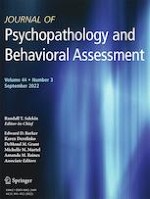19-02-2022
Trajectories of Behavioral Problems and Predictors in Children Aged 4 to 7 Years: a Growth Mixture Model Analysis
Gepubliceerd in: Journal of Psychopathology and Behavioral Assessment | Uitgave 3/2022
Log in om toegang te krijgenAbstract
The trajectories of behavioral problems have not been fully elucidated to date, particularly in the Chinese cultural context. This study attempted to delineate the trajectories of internalizing and externalizing problems and their predictors for Chinese children based on a longitudinal study. Three waves of data were collected from parent-reported questionnaires from a survey sample of 520 Chinese parents who had children aged 4 to 7 years. Unconditional and conditional growth mixture modeling was conducted in the study. The results showed that trajectories of internalizing and externalizing problems were heterogeneous in children 4 to 7, including Stable and Low pattern and Decreased pattern. The children’s gender, the number of children, and caregivers’ education levels predicted trajectories of internalizing and externalizing problems. These findings suggest that internalizing and externalizing problems may have different trajectories, and prevention strategies should be implemented based on specific subtypes. Additionally, the findings highlight that many more longitudinal studies should be conducted concerning the internalizing and externalizing problems and to examine their trends.
